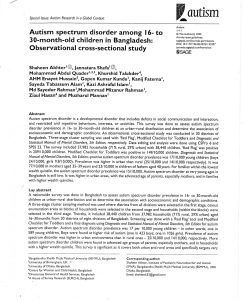
Asperger Syndrome is a neurobiological disorder named for a Viennese physician, Hans Asperger. Individuals with AS can exhibit a variety of characteristics and the disorder can range from mild to severe.
Key Characteristics:
- Deficiencies in social skills
- Difficulties with transitions or changes
- Prefer sameness (routine, structure
- Often have obsessive routines
- May be preoccupied with a particular subject of interest (eg. Maps, trains, snakes)
- Great difficulty reading non-verbal cues (body language)
- Often very sensitive to sound, light, taste, smell.
- Language acquisition is oftern normal.
- Pedantic and monotonic speech.
Classroom Strategies:
Transitions
- A child with AS may have a great deal of difficulty with transitions. Having a picture or word schedule may be helpful.
- Try to give as much advance notice as possible if there is going to be a change or disruption in the schedule. (eg. Before going on a field trip.)
- Giving one or two warnings before a change of activity or schedule may be helpful. (“Tomorrow we will be going to the museum, no math, no English, no PT period”)
Sensory Motor Skills/Auditory Processing
- Breaking directions down into simple steps is quite helpful (“first read pg. 40, then answer questions on pg. 42”)
- Using picture cures or directions may also help.
- Speaking slower and in smaller phrases can help.
Stimuli
- Children with AS may get overstimulated by loud noises, lights, strong tastes or textures, because of the greater sensitivity to these things.
- With lots of other kids, chaos and noise, please try to help a child with AS find a quiet spot to which he/she can go for some “comfort”. (You can ask to the child to have 5 min in that comfort zone when things get difficult.)
- Unstructured times (such as lunch, break and PE) may prove to be the most difficult for these children. Please try to help provide some guidance and extra adults help during these more difficult times.
- Allow the child to “move about” as sitting still for long periods of time can be very difficult (even a 5 minute walk around, with a friend or aide can help a lot).
Visual Cues
- Some children with AS learn best with visual aides, such as picture schedules, written directions or drawings (other children may do better with verbal instruction.)
- Hand signals may be helpful, especially to reinforce certain messages, such as “wait your turn“, “stop talking” (out of turn), or “speak more slowly or softly“.
Interruptions
- At times, it may take more than few seconds for a child with AS to respond to questions. He/she needs to stop what they’re thinking, put that somewhere, formulate an answer and then respond. Please wait patiently for the answer and encourage others to do the same. Otherwise, they will have to start over again.
- When someone tries to help by finishing his/her sentences or interrupting, he/she often has to go back and start over to get the chain of thought back.
Eye Contact
- At times, it looks as if a child with AS is not listening to you when he/she really is. Don’t assume that because he/she is not looking at you that he/she is not hearing you.
- Unlike most of us, sometimes forcing eye contact BREAKS concentration.
- The child may actually hear and understand you better if not forced to look directly at your eyes.
Social Skills and Friendships
- Here lays one of the biggest challenges for children with AS. They may want to make friends very badly, yet not have a clue as to how to go about it.
- Identifying 1 or 2 empathetic students who can serve as “buddies” will help the child feel as though the world is a friendlier place
- Talking with the other members of the class may help, if done in a positive way and with the permission of the family. For example, talking about the fact that many or most of us have challenges and that the AS child’s challenge is that he cannot read social situations well, just as others may need glasses or hearing aides.
Routine
- This is very important to most children with AS, but can be very difficult to attain on a regular basis in our world.
- Please let the child know of any anticipated changes as soon as you know them, especially with picture or word schedules.
- Let them know, if possible, when there will be a substitute teacher or a field trip occurring during regular school hours.
Language
- Although his vocabulary and use of language may seem high, children with AS may not know the meaning of what they are saying even though the words sound correct.
- Sarcasm and some forums of humour are often not understood.
Organizational Skills
- Children with AS lack the ability of remember a lot of information or how to retrieve that information for its use.
- It may be helpful to develop schedules (picture or written) for him.
- Posting schedules and homework assignments on the board and make a copy for him. Put the assignment into his backpack because he can’t always be counted on to get everything home without some help.
- If necessary allow to copy the notes of other children or you provide a copy. Many AS children are also dysgraphic and they are unable to listen to you talk, read the board and take notes at the same time.




 IPNA wants to create a world where children with developmental disabilities and their parents can get their questions answered and their needs met in a caring environment.
IPNA wants to create a world where children with developmental disabilities and their parents can get their questions answered and their needs met in a caring environment.